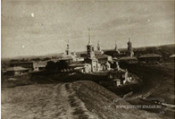
The first arithmetic school opened in Pereyaslavl-Ryazansky
7 (18) May 1722, in Ryazan, with the assistance of metropolitan Stephan Yavorsky, opened the first arithmetic primary school.
As directed by the Metropolitan of Ryazan and the governor-general of the Patriarchal throne, Stefan Yavorsky, it was the Simeon monastery that housed the arithmetic school. There, on the orders of the governor of province, V. A. Rzhevsky, in the spring of 1722 two small front rooms were constructed and the students were recruited. At the request of Yavorsky, the professor of the Petersburg Naval Academy, Peter Pavlov arrived to Ryazan on 8 (19) January 1722.
The arithmetic school opened its doors 7 (18) May 1722. It had an enrollment of 52 students from 10 to 17 years. The program included teaching of arithmetic, reading, writing and the basics of the Christian faith. In 1724 the successor of Stefan Yavorsky, Bishop Sylvester, began to arrange under the monastery a bishop school, different from the arithmetic one. In 1726 the second city school was opened. Initially, it had an enrollment of 70 students. When their number had risen to 269, the school moved to the Dukhovskoi monastery. As to the arithmetic school, it remained in the Simeon monastery, and only after the death of teacher of Pavlov in 1728, it was merged with the bishop school.
In 1730, Empress Anna Ivanovna issued a decree on the opening in every diocese of schools for the training of educated priests. In 1741 Archbishop Alexey converted the bishop school to the Latin school with a six-year period of study. In 1745, several graduates of the Pereslavl-Ryazan were sent to the Moscow Theological Academy to continue their education.
In 1748 the school burned down, and for some time it was housed in the Holy Trinity Monastery, and in 1752 began the construction of a building specially intended for the school. The school became known as the Theological Seminary, and the street where it was located bore the name of Seminarskaya Str.
The seminary was of class character – it accepted only the representatives of the clergy. Owing to this institution, in the 18th - first half of the 19th century the clergy was the most educated part of the inhabitants of the Ryazan region. Many graduates of the seminary became officials in the civil service. Among the seminary graduates were the first Ryazan teachers and doctors.
Lit.: Дегтев Ю. А. Рязань православная. Рязань, 1993; Мой родной город: история Рязани с древнейших времён. Рязань, 2007.
Based on the Presidential Library’s materials:
Based on the material of the Paustovsky Ryazan Regional Youth Library

